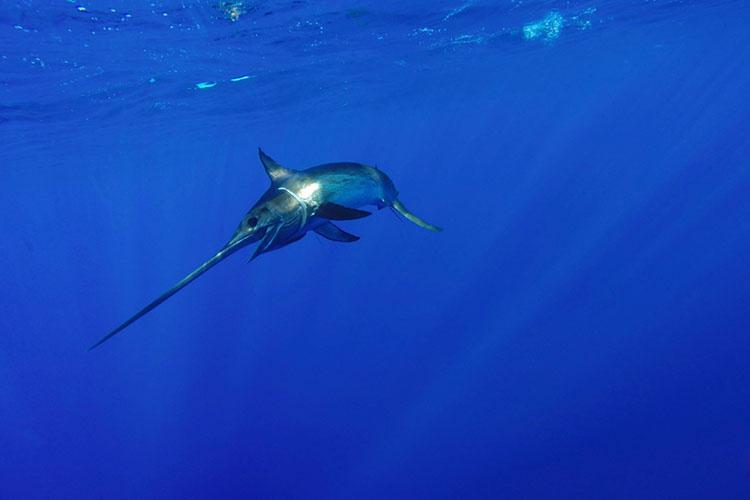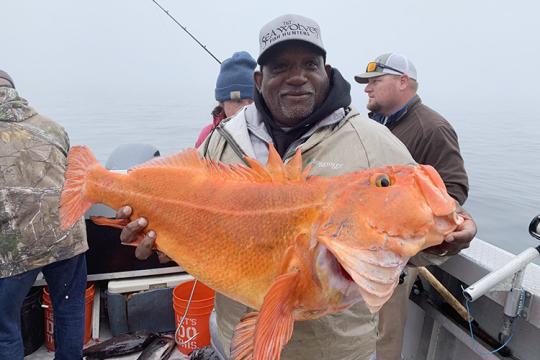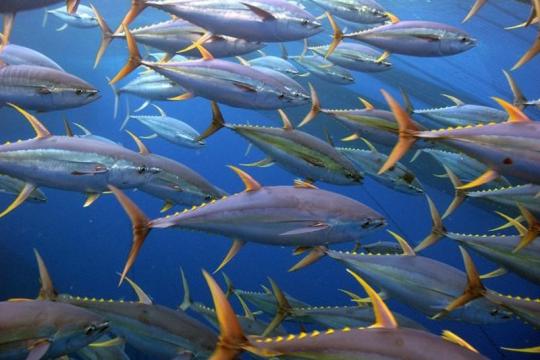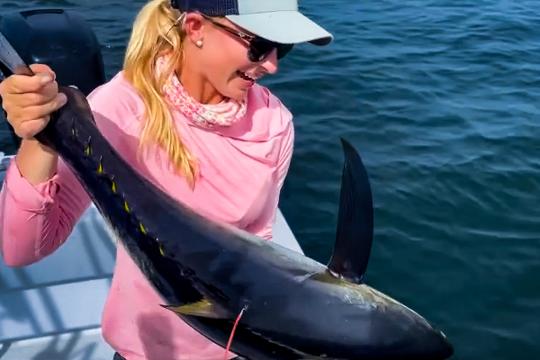 Swordfish swimming. Credit: Shutterstock/Joe Flynn
Swordfish swimming. Credit: Shutterstock/Joe Flynn
Swordfish swimming. Credit: Shutterstock/Joe Flynn
About the Species
 Swordfish swimming. Credit: Shutterstock/Joe Flynn
Swordfish swimming. Credit: Shutterstock/Joe Flynn
Swordfish swimming. Credit: Shutterstock/Joe Flynn
U.S. wild-caught north Atlantic swordfish is a smart seafood choice because it is sustainably managed and responsibly harvested under U.S. regulations.

Population
The stock is not overfished.

Fishing Rate
Not subject to overfishing.

Habitat Impact
Pelagic longline gear and handgear used to catch swordfish have no impact on habitat.

Bycatch
Regulations are in place to minimize bycatch.
Population Status
- According to the 2022 stock assessment, North Atlantic swordfish is not overfished and not subject to overfishing. Summary stock assessment information can be found on Stock SMART.
- The International Commission for the Conservation of Atlantic Tunas (ICCAT) assesses the abundance of swordfish in the Atlantic.
Appearance
- Swordfish have a long, flattened bill that looks like a sword, as their name implies.
- They have a stout, rounded body and large eyes.
- Their first dorsal (back) fin is tall and crescent-shaped. Their second dorsal fin is much smaller.
- Their anal fins (on their belly) are similar in shape to the dorsal fins but are smaller.
- They have a broad, crescent-shaped tail.
- Their color is darkest on top, generally black or brown, and fades to a lighter color below.
Biology
- Atlantic swordfish are one of the fastest predators in the ocean. Their streamlined body allows them to swim at high speeds, up to 50 mph.
- They grow quickly and reach a maximum size of about 1,165 pounds. However, the average size caught in the fishery is 50 to 200 pounds.
- Swordfish live about 9 years.
- Females are able to reproduce between 4 and 5 years of age. Depending on their size, females can produce anywhere from 1 million to 29 million eggs.
- They spawn multiple times throughout the year in warm tropical and sub-tropical waters.
- In the western North Atlantic, they spawn south of the Sargasso Sea and in the upper Caribbean from December to March, and off the southeast coast of the United States from April through August.
- Swordfish feed on a variety of fish and invertebrates such as squid.
- They capture prey by slashing their bill back and forth, stunning or injuring prey in the process.
- They have developed unique characteristics, such as a special eye muscles and a heat exchange system that allows them to swim in deep, cold water in search of prey.
- Swordfish feed at the top of the food chain and are rarely preyed on by other animals. Sharks and larger predatory fishes may sometimes eat juvenile swordfish.
Where They Live
Range
- Swordfish are found around the world in tropical, temperate, and sometimes cold waters of the Atlantic, Indian, and Pacific Oceans.
- They are found in the Gulf Stream of the Western North Atlantic, extending north into the Grand Banks of Newfoundland.
- North Atlantic swordfish annually migrate thousands of miles along the eastern seaboard of the United States and Canada and also in the eastern Atlantic along Africa and Europe.
Habitat
- Swordfish live in the surface to mid-water but feed throughout the water column.
- They move from spawning grounds in warm waters to feeding grounds in colder waters.
- The Gulf of America (formerly Gulf of Mexico) and Florida Straights are important nursery area for North Atlantic swordfish.
Fishery Management
- NOAA Fisheries, through the Atlantic Highly Migratory Species Management Division, manage swordfish in the North Atlantic.
- Managed under the 2006 Consolidated Atlantic Highly Migratory Species Fishery Management Plan:
- Permits are required.
- Pelagic longline and some handgear permits are limited access permits, which means that the number of available permits restricts the number of vessels fishing for swordfish.
- There are also commercial open access permits for handgear, with the exception of buoy gear.
- Annual catch limits.
- Minimum size requirements and landing restrictions.
- Reporting requirements documenting catch, fishing activities, and sales.
- Required to carry at-sea fisheries observers upon request.
- Compliance guides are available for all commercial and recreational regulations across Atlantic highly migratory species fisheries.
- Highly migratory species, such as swordfish, have complicated management that requires international cooperation.
- A swordfish that is off Massachusetts one week could be caught off the coast of Canada the next. These resources must be managed both in the United States and at the international level.
- NOAA works with the International Commission for the Conservation of Atlantic Tunas (ICCAT) on the management of international species, like swordfish.
- NOAA sets regulations for swordfish based on U.S. science, conservation and management, and recommendations from ICCAT.
Harvest
- Commercial fishery:
- U.S. swordfish landings consistently remain within the ICCAT-recommended quota, which contributes to maintaining a healthy stock throughout the North Atlantic Ocean.
- The majority of U.S. commercial landings come from the pelagic longline fleet, with a smaller portion of landings from handgear.
- Gear types, habitat impacts, and bycatch:
- Fishermen mainly use pelagic longline gear to harvest swordfish. They may also use rod-and-reel, harpoon, and buoy gear.
- Pelagic longline gear and handgear have no impact on habitat because they’re used in the water column and don’t come into contact with the ocean floor.
- Handgear used to catch swordfish is very selective and bycatch is minimal.
- NOAA Fisheries has taken the following additional measures to prevent bycatch and sustainably manage this fishery. Fishermen are:
- Required to use large circle hooks and certain types of bait that limit gear interactions with sea turtles. Circle hooks are specifically designed to minimize the damage caused by hooking, giving animals that are captured and released a better chance at survival.
- Trained and certified to use special techniques to safely de-hook and release incidentally caught turtles.
- Required to stop fishing and move 1 nautical mile if they encounter a protected species.
- Required to protect pilot whales and Risso's dolphins when fishing in the Mid-Atlantic Bight by limiting the length of their lines to 20 nautical miles and posting marine mammal handling/release guidelines on their vessels. In addition, if fishing in the Cape Hatteras Special Research Area, pelagic longliners must contact NOAA Fisheries at least 48 hours prior to a trip and carry observers if requested.
- Required to use weak hooks in the Gulf of America to reduce incidental catch of bluefin tuna, and are prohibited from using live bait to reduce bycatch of billfish.
- Restricted from areas in the Gulf of America to reduce bycatch of all species.
- Required to carry vessel monitoring systems onboard their boats to ensure compliance with regulations.
- Required to carry at-sea fisheries observers upon request. NOAA Fisheries reviews observer data to monitor protected species interactions and takes appropriate action as necessary.
- Recreational fishery:
- Recreational fishermen have fished for swordfish off the East Coast since the 1920s.
- Permits are required.
- Minimum size requirement and catch limits.
- Certain areas are closed to fishing during certain times of the year.
- Recreational fishermen must also report their swordfish catch by web, mobile app, or by phone 888-872-8862. If they release the fish, they must release it without removing it from the water in a manner that ensures it has a good chance of survival.
- Compliance guides are available for all recreational regulations across Atlantic highly migratory species fisheries.
Scientific Classification
- Swordfish are found around the world in tropical, temperate, and sometimes cold waters of the Atlantic, Indian, and Pacific Oceans.
- They are found in the Gulf Stream of the Western North Atlantic, extending north into the Grand Banks of Newfoundland.
- North Atlantic swordfish annually migrate thousands of miles along the eastern seaboard of the United States and Canada and also in the eastern Atlantic along Africa and Europe.
- Swordfish live in the surface to mid-water but feed throughout the water column.
- They move from spawning grounds in warm waters to feeding grounds in colder waters.
- The Gulf of America (formerly Gulf of Mexico) and Florida Straights are important nursery area for North Atlantic swordfish.
Fishery Management
- NOAA Fisheries, through the Atlantic Highly Migratory Species Management Division, manage swordfish in the North Atlantic.
- Managed under the 2006 Consolidated Atlantic Highly Migratory Species Fishery Management Plan:
- Permits are required.
- Pelagic longline and some handgear permits are limited access permits, which means that the number of available permits restricts the number of vessels fishing for swordfish.
- There are also commercial open access permits for handgear, with the exception of buoy gear.
- Annual catch limits.
- Minimum size requirements and landing restrictions.
- Reporting requirements documenting catch, fishing activities, and sales.
- Required to carry at-sea fisheries observers upon request.
- Compliance guides are available for all commercial and recreational regulations across Atlantic highly migratory species fisheries.
- Permits are required.
- Highly migratory species, such as swordfish, have complicated management that requires international cooperation.
- A swordfish that is off Massachusetts one week could be caught off the coast of Canada the next. These resources must be managed both in the United States and at the international level.
- NOAA works with the International Commission for the Conservation of Atlantic Tunas (ICCAT) on the management of international species, like swordfish.
- NOAA sets regulations for swordfish based on U.S. science, conservation and management, and recommendations from ICCAT.
Harvest
- Commercial fishery:
- U.S. swordfish landings consistently remain within the ICCAT-recommended quota, which contributes to maintaining a healthy stock throughout the North Atlantic Ocean.
- The majority of U.S. commercial landings come from the pelagic longline fleet, with a smaller portion of landings from handgear.
- Gear types, habitat impacts, and bycatch:
- Fishermen mainly use pelagic longline gear to harvest swordfish. They may also use rod-and-reel, harpoon, and buoy gear.
- Pelagic longline gear and handgear have no impact on habitat because they’re used in the water column and don’t come into contact with the ocean floor.
- Handgear used to catch swordfish is very selective and bycatch is minimal.
- NOAA Fisheries has taken the following additional measures to prevent bycatch and sustainably manage this fishery. Fishermen are:
- Required to use large circle hooks and certain types of bait that limit gear interactions with sea turtles. Circle hooks are specifically designed to minimize the damage caused by hooking, giving animals that are captured and released a better chance at survival.
- Trained and certified to use special techniques to safely de-hook and release incidentally caught turtles.
- Required to stop fishing and move 1 nautical mile if they encounter a protected species.
- Required to protect pilot whales and Risso's dolphins when fishing in the Mid-Atlantic Bight by limiting the length of their lines to 20 nautical miles and posting marine mammal handling/release guidelines on their vessels. In addition, if fishing in the Cape Hatteras Special Research Area, pelagic longliners must contact NOAA Fisheries at least 48 hours prior to a trip and carry observers if requested.
- Required to use weak hooks in the Gulf of America to reduce incidental catch of bluefin tuna, and are prohibited from using live bait to reduce bycatch of billfish.
- Restricted from areas in the Gulf of America to reduce bycatch of all species.
- Required to carry vessel monitoring systems onboard their boats to ensure compliance with regulations.
- Required to carry at-sea fisheries observers upon request. NOAA Fisheries reviews observer data to monitor protected species interactions and takes appropriate action as necessary.
- Recreational fishery:
- Recreational fishermen have fished for swordfish off the East Coast since the 1920s.
- Permits are required.
- Minimum size requirement and catch limits.
- Certain areas are closed to fishing during certain times of the year.
- Recreational fishermen must also report their swordfish catch by web, mobile app, or by phone 888-872-8862. If they release the fish, they must release it without removing it from the water in a manner that ensures it has a good chance of survival.
- Compliance guides are available for all recreational regulations across Atlantic highly migratory species fisheries.
Scientific Classification
| Kingdom | Animalia | Phylum | Chordata | Class | Actinopterygii | Order | Istiophoriformes | Family | Xiphiidae | Genus | Xiphias | Species | gladius |
|---|
Last updated by NOAA Fisheries on 03/20/2025
Featured News

 Tuna. Credit: NOAA Fisheries
Tuna. Credit: NOAA Fisheries
 Lakelynn Devine prepares to release a yellowfin tuna with a conventional spaghetti tag (the red item sticking out near its dorsal fin) attached. Photo courtesy of Lakelynn and Blake Devine.
Lakelynn Devine prepares to release a yellowfin tuna with a conventional spaghetti tag (the red item sticking out near its dorsal fin) attached. Photo courtesy of Lakelynn and Blake Devine.

Seafood Facts

Is North Atlantic Swordfish Sustainable?
U.S. wild-caught north Atlantic swordfish is a smart seafood choice because it is sustainably managed and responsibly harvested under U.S. regulations.
Availability
Year-round, with peaks from June through October.
Source
U.S. wild-caught from U.S. Atlantic and Gulf of America (formerly Gulf of Mexico) waters.
Taste
Moist and flavorful with a slightly sweet taste.
Texture
Firm with moderate oil content.
Color
Raw flesh ranges from white and ivory to pink and orange. Cooked meat is beige.
Health Benefits
Swordfish is an excellent source of selenium, niacin, vitamin B12, and zinc.
Nutrition Facts
Servings: 1; Serving Weight: 100 g; Calories: 121 ; Protein: 19.8 g; Total Fat: 4.01 g; Total Saturated Fatty Acids: 1.097 g; Carbohydrate: 0 g; Total Sugars: 0 g; Total Dietary Fiber: 0 g; Cholesterol: 39 mg; Selenium: 48.1 mcg; Sodium: 90 mgMore Information
Swordfish Recipes
Looking for ways to add swordfish into your rotation? If you need some cooking inspiration, browse these recipes for grilled swordfish, swordfish skewers, and more!

Last updated by NOAA Fisheries on 03/20/2025
Seafood News
 Thomas Piecuch flips floating oyster bags on his farm (Credit: Holy Ground Oyster Company).
Thomas Piecuch flips floating oyster bags on his farm (Credit: Holy Ground Oyster Company).
Celebrating Aquaculture Week: Farming from Tide to Table
 NOAA team members adjust a prototyped turtle excluder device (TED) before sending it to divers below for continued testing on the NOAA R/V Caretta. Credit: NOAA Fisheries (ESA Permit 20339)
NOAA team members adjust a prototyped turtle excluder device (TED) before sending it to divers below for continued testing on the NOAA R/V Caretta. Credit: NOAA Fisheries (ESA Permit 20339)
Small Modifications to Turtle Excluder Devices Have Big Impacts for Gulf Sea Turtles
 Pacific oysters travel down a sorting tumbler at Salty Lady Seafood Company in Juneau, Alaska. Credit: Salty Lady Seafood Company.
Pacific oysters travel down a sorting tumbler at Salty Lady Seafood Company in Juneau, Alaska. Credit: Salty Lady Seafood Company.
 Commercial fishing boats lined up in Sitka, Alaska. Credit: Shutterstock.
Commercial fishing boats lined up in Sitka, Alaska. Credit: Shutterstock.
NOAA Fisheries Seeks Recommendations for Restoring American Seafood Competitiveness
Research
Top Fish Taggers for the Cooperative Tagging Center
NOAA Fisheries greatly appreciates the many tagging teams and anglers who tag and release fish to support our science.
Outreach & Education
Fisheries of the Northeast
More than 100 species, including finfish, shellfish, urchins, and seaweeds, are landed in the…
Atlantic Swordfish and Billfish Identification Guide
Provides guidance on how to identify species of Atlantic swordfish and billfishes.
Last updated by NOAA Fisheries on 03/20/2025



